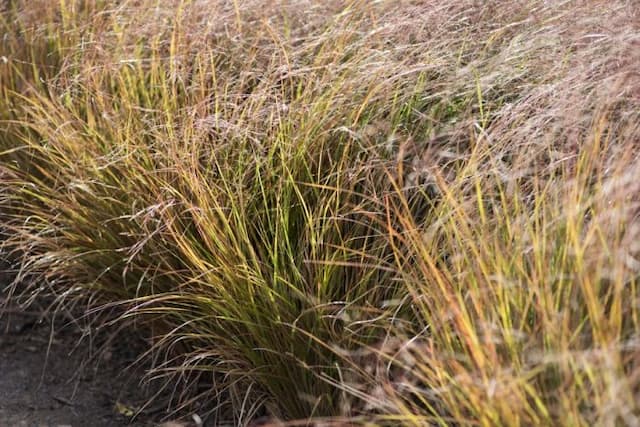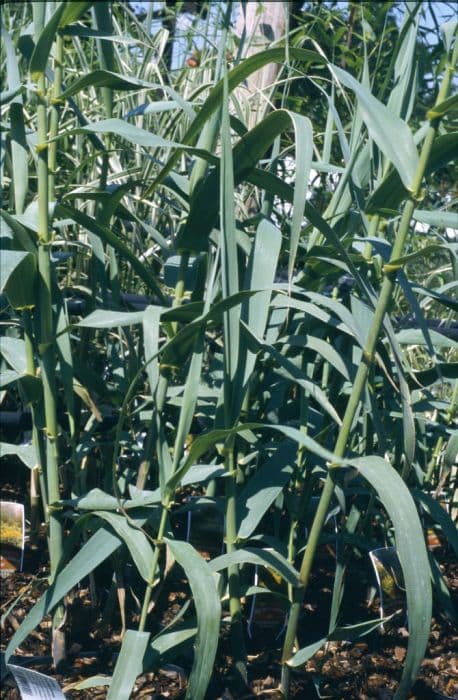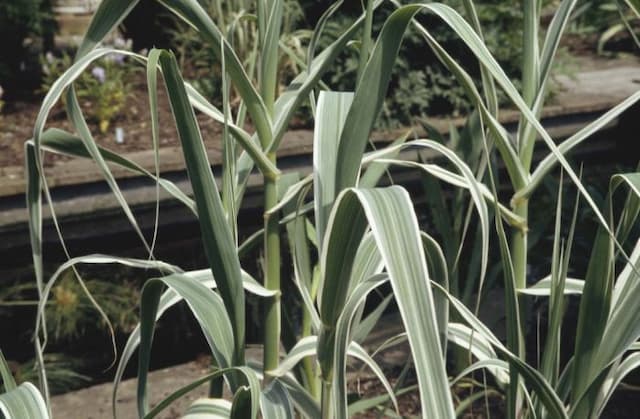Marble Bamboo Chimonobambusa marmorea











ABOUT
Chimonobambusa marmorea, commonly known as Marble Bamboo, is a unique and striking bamboo variety. This plant features a beautiful combination of color and pattern on its culms, which are the main stems and are distinctive for their marbled appearance—thus, the common name Marble Bamboo. These stems display a mix of green shades swirled with a creamy variegation that gives the plant its remarkable look. The leaves of Marble Bamboo are narrow and elongated, contributing to an overall graceful and elegant foliage display. The color of the leaves is a rich, vibrant green, which can create a lush and tropical ambience in a garden or when used as an indoor plant. The arrangement of the leaves along the culms is typically quite dense, giving the plant a rather full and bushy appearance that can provide a good amount of shade and visual interest. The culms themselves tend to have a smooth texture and may become more pronounced in coloring as the plant matures. As with many bamboo species, the stems grow closely together, forming tight clusters that make Marble Bamboo an excellent choice for creating natural screens or hedges. Throughout the seasons, the appearance of Marble Bamboo may change slightly, as the colors can fluctuate in intensity, providing a dynamic element to the plant's overall look. The contrast between the creamy marbling and the green of the stems and leaves is particularly appreciated by gardeners and landscapers looking for a plant with a strong decorative appeal.
About this plant
 Names
NamesFamily
Poaceae
Synonyms
Marble Bamboo, Kan-chiku
Common names
Qiongzhuea marmorea, Arundinaria marmorea.
 Toxicity
ToxicityTo humans
There is limited specific information available regarding the toxicity of Chimonobambusa marmorea, commonly known as marble bamboo, to humans. It is not typically considered a poisonous plant to humans. Most bamboos are not known for being toxic, and there are no well-documented cases of poisoning from ingesting Chimonobambusa marmorea. As with any plant, individual allergies may exist, and it's always possible for someone to have a unique reaction, but generally, marble bamboo is not recognized for having toxic effects on humans.
To pets
Similarly to its effects on humans, Chimonobambusa marmorea, commonly known as marble bamboo, is not widely recognized as being toxic to pets. There is a lack of specific reports or studies on the plant causing poisoning in pets. Generally, bamboos are not listed among the plants that are known to be hazardous to dogs, cats, or other domestic animals. However, consuming non-food items in large quantities can lead to gastrointestinal upset or blockage in pets, so it is wise to prevent pets from ingesting substantial amounts of any plant material, including marble bamboo.
 Characteristics
CharacteristicsLife cycle
Perennials
Foliage type
Evergreen
Color of leaves
Green
Height
15 feet [4.57 meters]
Spread
6 feet [1.83 meters]
Plant type
Shrub
Hardiness zones
8
Native area
China
Benefits
 General Benefits
General Benefits- Aesthetic Appeal: Chimonobambusa marmorea, also known as "Marble Bamboo," adds visual interest to gardens with its unique mottled stems and lush foliage.
- Landscape Design: It can be used as an ornamental feature, in a container or as part of a bamboo garden theme.
- Sound Ambiance: The gentle rustling of leaves and canes in the breeze can create a soothing sound environment.
- Privacy Screen: Growing Marble Bamboo in rows or clusters can provide a natural, tall barrier for privacy.
- Shade Provider: Its dense foliage can offer cool shaded areas within a garden or yard.
- Erosion Control: The extensive root system of these bamboos helps to stabilize soil and prevent erosion.
- Growth Control: Unlike some bamboos, Chimonobambusa marmorea is less invasive, making garden management easier.
- Habitat for Wildlife: Many species of birds and insects find shelter and food within the dense branches of these bamboos.
- Cultural Significance: Bamboo is a plant often associated with tranquility and resilience and can bring a sense of calm to a garden space.
- Craft and Construction: Though not specifically for Chimonobambusa marmorea, bamboos are traditionally used in craft, construction, and making instruments.
 Medical Properties
Medical PropertiesThis plant is not used for medical purposes.
 Air-purifying Qualities
Air-purifying QualitiesThis plant is not specifically known for air purifying qualities.
 Other Uses
Other Uses- As a Craft Material: The canes of Chimonobambusa marmorea, commonly known as Marble Bamboo, are used for making decorative objects and intricate crafts due to their unique marbled appearance.
- In Musical Instruments: The hard and dense canes may be used to create musical instruments like flutes or other wind instruments, prized for their aesthetic appeal and the tonal qualities of the bamboo.
- In Photography: Photographers sometimes use Marble Bamboo groves as a stunning, natural backdrop for portrait and landscape photography, taking advantage of the plant's striking visual patterns.
- For Fencing and Barriers: The robust canes make effective natural fences or garden barriers, providing privacy while also adding an ornamental touch to landscapes.
- As a Living Support Structure: Gardeners can use Marble Bamboo as a living trellis for climbing plants, which can create a visually appealing symbiotic feature in gardens.
- For Soundproofing: Due to its density, Marble Bamboo can be used in the construction of soundproofing walls or barriers in residential or commercial settings.
- In Textile Production: Although not commonly known for this, the fibers from Marble Bamboo could be used to create textiles or woven fabrics with a distinct texture and pattern.
- As Vegetable Garnish: Young shoots of Marble Bamboo may be used as an artistic garnish in gourmet cuisine, offering both visual flair and a subtle bamboo flavor.
- For Culinary Tools: The bamboo's hardiness makes it ideal for creating durable kitchen utensils, such as cutting boards or serving platters that showcase its beautiful marbling.
- In Educational Tools: Sections of Marble Bamboo can be used as natural geometric shapes or counting tools in educational settings, especially for teaching about the environment and sustainability.
Interesting Facts
 Feng Shui
Feng ShuiThe plant Chimonobambusa marmorea, commonly known as the marble bamboo, is not used in Feng Shui practice.
 Plant Symbolism
Plant Symbolism- Resilience: Similar to other bamboo species, Chimonobambusa marmorea, commonly known as Marble Bamboo, is symbolic of resilience due to its ability to bend in the face of adversity without breaking.
- Flexibility: Reflecting the plant’s physical properties, Marble Bamboo is often associated with flexibility, showing the importance of adapting to shifting circumstances to thrive.
- Growth: Bamboo plants are known for their rapid growth, and Marble Bamboo is no exception; it exemplifies personal growth and the continual pursuit of improvement.
- Longevity: Marble Bamboo is also symbolic of longevity, relating to the long life span of bamboos and their capability to survive under various conditions for years.
- Good Fortune: In many cultures, bamboo plants are considered lucky, and possessing Marble Bamboo is believed to bring good fortune and prosperity to its keepers.
 Water
WaterThe Turtle Tail Bamboo should be watered thoroughly but infrequently, allowing the soil to dry out slightly between waterings. Typically, this would mean watering once weekly, providing about 1 to 2 gallons depending on the size of the plant and the environmental conditions. Over-watering can lead to root rot, so it's crucial to ensure good drainage. In hotter and drier climates, more frequent watering may be necessary to keep the soil consistently moist but never soggy. During the winter months, reduce watering to reflect the plant's reduced growth rate.
 Light
LightTurtle Tail Bamboo prefers bright, filtered light or partial shade. Directly placing it in full sun can cause leaf scorch, while too much shade can result in weak growth. The ideal spot for this plant is an area where it receives morning sun and afternoon shade, providing a balance of light throughout the day.
 Temperature
TemperatureTurtle Tail Bamboo thrives in temperatures between 60 and 80°F, resisting fluctuations well within this range. It can tolerate minimums down to 50°F but should be protected from frost. Extended exposure to temperatures outside this range, either too hot or too cold, can cause stress to the plant.
 Pruning
PruningPruning Turtle Tail Bamboo helps maintain its shape and remove any dead or damaged canes. Pruning should be done during the late winter or early spring before new growth begins. This annual pruning will encourage healthy new shoots and help manage the size of the plant. Always use clean, sharp tools to make clean cuts.
 Cleaning
CleaningAs needed
 Soil
SoilThe Marble Bamboo requires a well-draining potting mix with a high content of organic matter. A blend of two parts loam, one part peat moss or coconut coir, and one part perlite or sand creates an ideal environment. The optimal soil pH for Marble Bamboo is between 5.5 and 7.0.
 Repotting
RepottingMarble Bamboo should be repotted every two to three years to prevent it from becoming root-bound and to replenish its nutrients. Spring is the best time for repotting as the plant is entering a period of active growth.
 Humidity & Misting
Humidity & MistingMarble Bamboo prefers a moderate to high humidity level, around 40-60%. If grown indoors, it may benefit from regular misting or use of a humidifier to maintain these humidity conditions.
 Suitable locations
Suitable locationsIndoor
Place Marble Bamboo in bright, indirect light inside.
Outdoor
Grow in partial shade and protect from strong winds.
Hardiness zone
7-9 USDA
 Life cycle
Life cycleChimonobambusa marmorea, commonly known as Marble Bamboo, begins its life cycle as a seed, germinating in the right conditions of warmth and moisture to produce a small shoot. This shoot grows rapidly, benefiting from the high energy reserves of the seed, and soon establishes itself as a seedling with a developing root system. The seedling matures into a culm, the main stem of the bamboo, which elongates and produces branches and leaves, engaging in photosynthesis for growth and energy production. As it matures, Marble Bamboo develops rhizomes, underground stems that spread to produce new clumps of culms. Flowering is rare and unpredictable, occurring only once in the plant's lifetime, which can be several decades, after which it sets seeds before dying. Following seed set, the plant disperses these seeds, which then begin the cycle anew if conditions allow.
 Propogation
PropogationPropogation time
Spring-Early Summer
Propogation: The most popular method of propagating the Chinese bamboo, also known as Chimonobambusa marmorea, is by dividing the rhizomes. This process is best done in the spring when the plant is actively growing. Dig around the base of an established clump and gently separate a section of rhizome with a sharp spade, ensuring it has at least one or two growth buds. These sections can then be planted in soil rich in organic matter, maintaining a depth of about 2 to 3 inches (5 to 7.5 centimeters) to allow new shoots to push through easily. Adequate watering should follow to establish the new plant.









